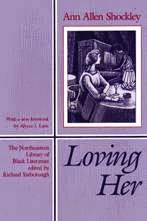LGBT History Month: Ann Allen Shockley’s Loving Her, 40 Years Later
 In honor of LGBT History Month, the HBW Blog will be featuring a series of posts on foundational queer texts by African American authors. First up: Ann Allen Shockley’s Loving Her (1974).
In honor of LGBT History Month, the HBW Blog will be featuring a series of posts on foundational queer texts by African American authors. First up: Ann Allen Shockley’s Loving Her (1974).
From Nella Larsen’s Passing (1929) to Toni Morrison’s Sula (1973), the history of African American literature is rich with work that covertly addresses themes of lesbian desire. These readings are now so commonly accepted that Sula, for instance, is often spoken of flatly as a “lesbian novel,” even though its lesbian content is almost entirely subtextual.
The first African American novel to deal explicitly with lesbianism was Ann Allen Shockley‘s Loving Her, published in 1974, just one year after Morrison’s groundbreaking novel. Although neither as artistically nor popularly successful as Sula (or Passing, for that matter), Loving Her is a tremendously important contribution to the history of African American fiction.
Novelist and critic Jewelle Gomez has said that “For Black Lesbians,” reading Loving Her “was like reading The Well of Loneliness
[Radclyffe Hall’s 1928 novel, the first to openly feature lesbian
characters and relationships] for the first time as teenagers and
realizing there were ‘others’ out there.”
A relatively slim 187 pages, Loving Her tells the story of Renay, a black musician, who takes her daughter Denise and leaves her abusive husband in order to be with Terry, a rich white lesbian who frequents the bar where Renay plays piano. When Renay’s husband Jerome Lee learns about Terry and Renay’s relationship, he beats Renay almost to death and kidnaps his daughter, who dies in a car wreck caused by her father’s drunk driving. Convinced Denise’s death is God’s punishment for her love of Terry, Renay leaves her lover, only to eventually return and rekindle their relationship at the end of the novel.
For most critics, Loving Her‘s value lies chiefly in its status as “first”–both the first openly lesbian relationship in an African American novel and the first openly lesbian African American protagonist, as Alycee J. Lane points out in her foreword to the Northeastern Library of Black Literature edition of the novel. Although Loving Her certainly suffers from stylistic concerns–particularly its florid and often pedantic prose–its importance can be felt through its depiction of the loving and forthrightly sexual relationship between Terry and Renay, whose relationship opens the door for future representations of lesbian relationships, such as The Color Purple‘s Celie and Shug. Scholars interested in the history of queer, and especially lesbian, representation in African American and American literature could find much to discuss in the novel.
As Loving Her celebrates its 40th anniversary, the time is ripe to revisit this somewhat overlooked text. Engaging themes of race, sex, class, sexuality, and nationalism, Loving Her is a far richer novel than has often been realized.